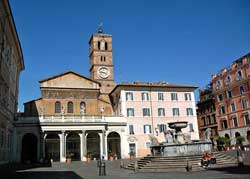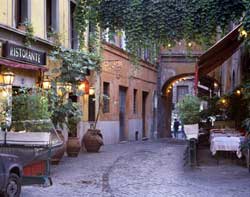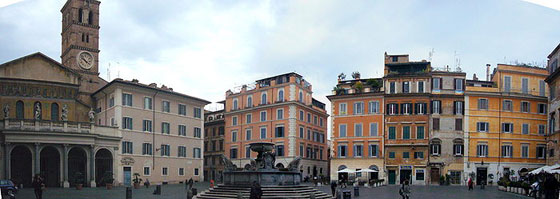Trastevere Rome Walking Tour
This ancient Trastevere walking tour covers the highlights of the old city.
View Walking Tour of Trastevere Rome in a larger map
Trastevere Rome Street Map
 Church of San Crisogono
Church of San Crisogono
The first church on crossing Ponte Garibaldi is the Church of St. Crisogno , founded by Pope Sylvester and rebuilt in 731AD. It features a 12th century tower, 17th century facade and the High Altar dates from 1127AD.
 Piazza and Church of San Benedetto a Piscinula Church
Piazza and Church of San Benedetto a Piscinula Church
From the Piscinula you can see the oldest working bell tower in Rome, dating from 1069AD. There use to be 300 of these bell towers...only about 50 remain.
The tiny St. Bendetto a Piscinula Church with its ancient pillars is named after St. Benedict who lived in a house here before his retreat to Subiacco. There is a picture of the Virgin and Child in the vaulted chapel where St. Benedict used to come to pray. Over the High Altar is a painting of St. Benedict. Check out the Cell of the Saint with its rough-hewn stones....note the stone pillow.
 Basilica of Cecilia in Trastevere
Basilica of Cecilia in Trastevere
 |
The beautiful Santa Cecilia in Trastavere and courtyard is one of the most interesting buildings in the city. The water vessel in the center of the courtyard is ancient. The foundation dates from its consecration by Pope Urban I in 180AD. It was given by St. Cecilia as a gift upon her death bed. She wanted a "temple to the Savior" to be built over the house where she lived. It was rebuilt in 821 by Paschal I and modernized by Cardinal Doria in 1725. St. Cecilia was martyred here in her home in the bathroom. She was locked in the bathroom, then there was an attempt to kill her by suffocation and heat and when that failed she was hacked to by sword but still lived for a few days after this brutal attack.

Statue of Incorrupt St. Cecilia
by JoJan
Pope Pascal I was retrieving the bodies of saints 500 years later in the catacombs and couldn't find Cecilia's body. He had a dream that he would find it and continued the search. Her body was found intact and incorrupt then brought to the new church he had built. In 1599, when Cardinal Sfondrati was repairing the church it is told that the sculptor Stefano Maderno was allowed to see the body. He then sculpted the beautiful life size statue of the still incorrupt body as he saw it. It is in front of the altar of St. Cecilia Church. There is a mural painting depicting the Final judgment (1289-93) by Pietro Cavallini in the choir.
Descend the iron staircase in the sacristy on the left to see excavations of a 1st & 3rd century house with mosaic pavements and the early 4th century basilica. You will also find the beautiful crypt with the relics of St. Cecilia and St. Valerian, her husband.
To the right of the church is a Blessed Sacrament Chapel with medieval frescoes. Another corridor leads to a chapel which is said to be the spot where St. Cecilia was martyred.
The Adjacent convent houses Benedictine nuns who care for the lambs blessed at St. Agnes's Basilica. Their wool is used for the pallium near St. Peter's tomb. To the left of St. Cecilia's is the San Giovanni dei Genovesi (St. John's of the Genoese) beautiful renaissance courtyard.
 Church of St. Maria del Orto
Church of St. Maria del Orto
Check for bulletins on the doors of Santa Maria dell' Orto Church (Our Lady of the Garden) for a schedule of sacred concerts that are held here.
 San Francesco a Ripa Church
San Francesco a Ripa Church
Benedictine monks in the early 13th century had a hospice for travelers here and the beloved St. Francis stayed here on his visit to Rome in 1229. You can see his cell through the church to left corner sacristy and ask a friar to see the "Stanza di San Francesco" with luck you will see the carefully preserved room upstairs. The Baroque altarpiece of 1698 is said to contain over 1000 relics! The Church of San Francesco d'Assisi a Ripa has a portrait of St. Francis by Margheritone d'Arezzo. In the last chapel on the left is a beautiful sculpture of Blessed Ludovica Albertone by Bernini who became a tertiary after her husband died.
 San Cosimato in Trastevere Rome
San Cosimato in Trastevere Rome
The door of Church of St. Cosimato has medieval wood carvings. To the left of the altar is a beautiful fresco by Pinturicchio of St. Francis and St. Clare on either side of the Virgin and Child. At the end of the left aisle, a chapel is decorated with frescoes and a beautiful altar from 15th century.
 Santa Maria in Trastevere Rome
Santa Maria in Trastevere Rome
 |
The Piazza of Santa Maria in Trastevere Rome has a lovely fountain by Carlo Fontana from the 17th century. This piazza was where 8 priests were brutally murdered in the Revolution of 1849.
The Church of St. Maria in Trastevere was the first church in Rome dedicated to the Virgin Mary. It is said to be founded by St. Calixtus in AD 221/2 as an oratory for the Christians. The first church was built here by Pope St. Julius in 340AD and after being damaged by fire during the sack of Rome in 410, Pope Celestin repaired and rededicated it to the Virgin Mary. Major reconstruction started again in 1139AD by Innocent II, finished by Eugenius III and consecrated in 1198 by Pope Innocent III.
The faded mosaics on the facade date from the 12th or 13th centuries. In the portico you can find ancient fragments of monuments and catacomb inscriptions from the earlier churches 3rd through the 9th centuries and 2 frescoes of the Annunciation, one by Cavallini.
Inside the Narthex, the walls have early Christian and pagan inscriptions from the 3rd century and one from the time of Trajan, 98-117AD.
The apse vault mosaic is the Coronation of the Virgin surrounded by saints and Pope Innocent II holding a model of the church. The lower aspe mosaics by Pietro Cavallini from the 13th century, depict the life of the Virgin Mary. ....birth of Our Lady with St. Ann, Annunciation, nativity, Epiphany, presentation in the Temple and Falling asleep of Mary.
In the Sacristy is a painting by Perugino of the Virgin Mary with St. Rocco and St. Sebastiano and mosaics of birds and fish which are probably 1st century work from a pagan temple or the catacombs.
Beneath the High altar are the remains of 5 early popes and the church holds the relic of the head of Saint Apollonia and a portion of the Holy Sponge.
 Church of Santa Maria della Scala
Church of Santa Maria della Scala
At the end of the 16th century, a mother with a deformed child came to pray often beneath a painting of the Virgin Mary at the top of a staircase in a home and finally begged the Madonna to heal her child saying she would grant any favour she asked of her. The child was healed at once which resulted in the townspeople enthusiastically building the church of Santa Maria della Scala or Our Lady of the Staircase in this spot.
Inside the St. Maria della Scala Church to the right is an altar to honor St. Teresa of Avila with a relic of her foot. The altar opposite of this holds the image of the Madonna of the Staircase. A nearby chapel has an impressive sculpture of St. John of the Cross.
 Santa Dorotea Church Rome
Santa Dorotea Church Rome
Santa Dorotea was a 14 year old virgin martyr. Dorothy is buried here and her bones are clothed in wax in a glass coffin beneath the high altar.
 Villa Farnesina Trastevere Rome
Villa Farnesina Trastevere Rome
 |
 Corsini Gallery
Corsini Gallery

Across from the Villa Farnesina is the Palazzo Corsini and the Corsini Gallery. This is a lovely, quiet out of the way gallery with paintings of Renaissance Rome, a Flemish section, Canaletto's views of Venice, Caravaggios and more. The admission charge is currently 4 euro for this Trastevere Rome museum.
Gianicolo Hill Walk
Gianicolo Hill and if you walk to the top you will be rewarded with some of the best views of Rome.
 Church of Saint Pietro in Montorio & Tempietto
Church of Saint Pietro in Montorio & Tempietto
Follow Via Garibaldi to the Saint Pietro in Montorio Church. The first chapel to the right has a beautiful painting of the scourging of Christ by Sebastiano del Piombo. To the left as you enter is a wonderful painting of the Stigmata of St. Francis by Giovanni de Vechi. The next chapel has a sculpture of St. Francis in Ecstasy by Baratta. There are other interesting art pieces in this church including a mosaic above the high altar of St. Peter's upside down crucifixion.
Don't miss the famous, tiny Tempietto by Donato Bramante next door which is regarded as a masterpiece of the Renaissance. It was built to commemorate the martyrdom of St. Peter in 1502. In the upper chapel there is a relief of the martyrdom of St. Peter and the Dome by Bernini depicts the life of St. Peter.
 Fontana del Gianicolo
Fontana del Gianicolo
Continue up the hill and stop at the grand Gianicolo Fountainmade in 1612 by Flaminio Ponzio and Giovanni Fontana part of Paul V's Acqua Paola.
 Piazza Ganicolo
Piazza Ganicolo

Turn right onto Passeggiata del Gianicolo up to the Piazza Gianicolo with beautiful sweeping views of the City of Rome. This view a little before sundown is a stunning panorama of Rome bathed in warm colors.
De trotse en zeer eigenwijze inwoners van Trastevere, dat letterlijk aan de overkant van de Tiber betekent, beschouwen zichzelf als de echte Romeinen. In deze schilderachtige oude volkswijk loop je zo tegen taferelen aan die uit voorbije eeuwen lijken te stammen. Verscholen in een wirwar van nauwe, geplaveide straatjes liggen enkele van de interessantste middeleeuwse kerken van Rome. Slechts een toevallige glimp van een romaanse klokkentoren verraadt hun ligging.
 Het middelpunt van de wijk wordt gevormd door de Santa Maria in Trastevere, die volgens de inwoners van Trastevere de eerste christelijke kerk is die in Rome werd gebouwd. Hier zou in de derde of vierde eeuw voor Christus namelijk al een kerk hebben gestaan, maar de huidige basiliek is nog niet zo oud. De kerk zoals die er nu staat zou in de 12e eeuw gebouwd zijn.
Het middelpunt van de wijk wordt gevormd door de Santa Maria in Trastevere, die volgens de inwoners van Trastevere de eerste christelijke kerk is die in Rome werd gebouwd. Hier zou in de derde of vierde eeuw voor Christus namelijk al een kerk hebben gestaan, maar de huidige basiliek is nog niet zo oud. De kerk zoals die er nu staat zou in de 12e eeuw gebouwd zijn.Uit diezelfde tijd stammen ook de schitterende mozaieken op de gevel van Maria die Jezus voedt en wordt omringd door tien vrouwen met lichtjes in hun handen. De vrouwen met de brandende lampjes staan symbool voor de maagdelijkheid; de vrouwen met gedoofde lampjes zijn waarschijnlijk weduwen. Ook binnen is een prachtig mozaiek te zien, ditmaal met een afbeelding van de kroning van Maria.
De bouw van de Santa Maria in Trastevere heeft soms letterlijk een gat geslagen in het oude Rome; zo zou een deel van het bouwmateriaal zijn gestolen uit de Thermen van Caracalla. Dat maakt de zuilen niet minder mooi, maar het is wel vreemd te bedenken dat de bouw van een prachtige kerk ten koste is gegaan van het behoud van de oude gebouwen van het enorme thermencomplex.
Aan het Piazza di Santa Maria in Trastevere vind je een aantal gezellige terrasjes en restaurantjes. Vooral bij Caffe degli Aranci is het goed toeven; het versgeperste sinaasappelsap is echt een aanrader!
 Even verderop, aan het Piazza Sant'Egidio, vind je Ombre Rosse, een gezellige kroeg met dito terras waar je even kunt bijkomen met een koffie, een glas wijn en een broodje. Vaak worden hier exposities georganiseerd, en in het weekend zijn er regelmatig concerten.
Even verderop, aan het Piazza Sant'Egidio, vind je Ombre Rosse, een gezellige kroeg met dito terras waar je even kunt bijkomen met een koffie, een glas wijn en een broodje. Vaak worden hier exposities georganiseerd, en in het weekend zijn er regelmatig concerten.Aan dit plein vind je ook het Museo di Roma in Trastevere. Hier begrijp je pas echt waarom de inwoners van Trastevere vinden dat alleen zij zich echt Romeinen mogen noemen. Het museum heeft allerlei prenten over de feesten, spelletjes en tradities van de Romeinen, die in Trastevere vaak nog springlevend zijn en ook door jongere generaties in ere worden gehouden.
Naast het museum ligt de Sant'Egidio, de kerk van een zeer actieve geloofsgemeenschap die ooit is opgericht om arme mensen op te vangen en te eten te geven. Nog steeds is deze gemeenschap heel actief en zie je de inwoners van Trastevere regelmatig met boodschappen sjouwen voor een grote lunch of een feestelijk diner voor de buren en vrienden die het minder hebben getroffen.
Aan de Via delle Luce vind je Biscottificio Innocenti, een klein koekjesfabriekje waar ze de lekkerste koekjes van Rome maken. Terwijl je je koekjes bestelt, zie je de meest lekkere variaties uit de oven komen. Hier kan elke zoetekauw zijn hart ophalen: brutti ma buoni, cantuccini, amaretti, crostata... Kies wat lekkers uit, wandel naar een barretje in de buurt, bestel een kopje koffie en geniet!
Een van de minder bekende plekken in Trastevere is de San Francesco a Ripa. Bij zijn bezoek aan Rome in 1219 verbleef Franciscus van Assisi hier. Zijn (stenen) kussen en crucifix zijn bewaard gebleven. Het oorspronkelijke gebouw staat er echter niet meer. Hoogtepunt in de huidige kerk is de Paluzzi-Albertoni-kapel, met Bernini’s adembenemende De extase van Beata Ludovica Albertoni.











































No comments:
Post a Comment